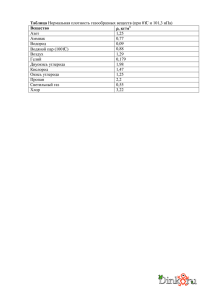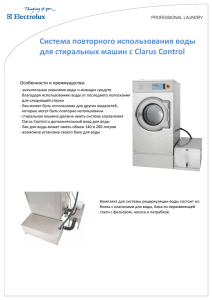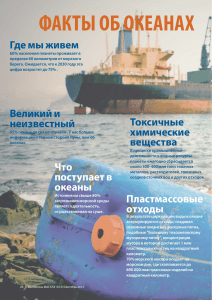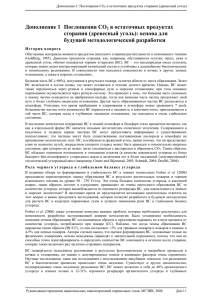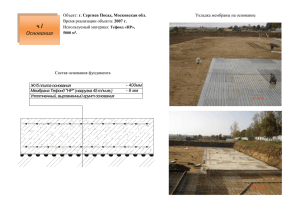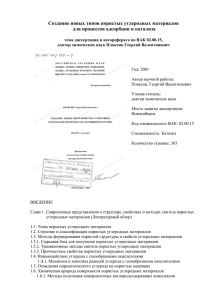СТРУКТУРА БИОМАССЫ И СТОК УГЛЕРОДА ПОДРОСТА ЕЛИ В
реклама
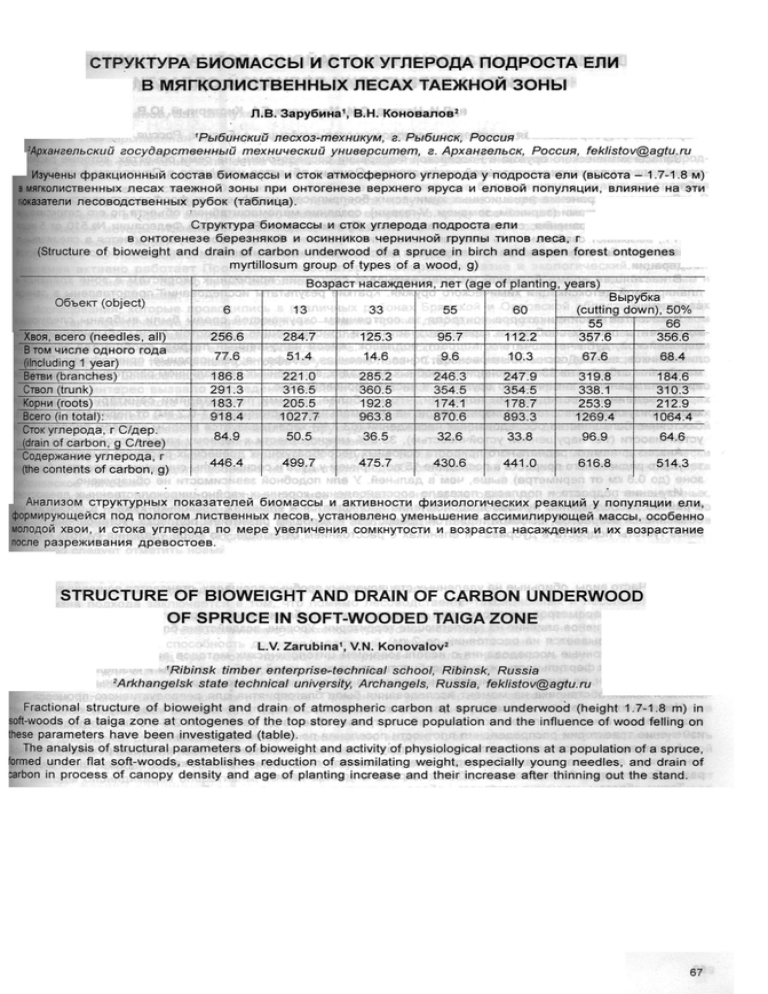
СТРУКТУРА БИОМАССЫ И СТОК УГЛЕРОДА ПОДРОСТА ЕЛИ В МЯГКОЛИСТВЕННЫХ ЛЕСАХ ТАЕЖНОЙ ЗОНЫ 1 Л.В. Зарубина , В.Н. Коновалов 2 •r-v---Рыбинский лесхоз-техникум, г. Рыбинск, Россия Архангельский государственный технический университет, г. Архангельск, 1 Россия, feklistov@agtu.ru изучены фракционный состав биомарсы и сток атмосферного углерода у подроста ели (высота - 1.7-1.8 м) иягколиственных лесах таежной зоны при онтогенезе верхнего яруса и еловой популяции, влияние на эти азатели лесоводственных рубок (таблица). Структура биомассы и сток углерода подроста ели в онтогенезе березняков и осинников черничной группы типов леса, г (Structure of bioweight and drain of carbon underwood of a spruce in birch and aspen forest ontogenes myrtillosum group of types of a wood, g) Возраст насаждения, лет (age of planting, years) Объект (object) воя, всего (needles, all) j том числе одного года (including 1 year) Ветви (branches) Ствол (trunk) Корни (roots) Всего (in total): Сток углерода, г С/дер. (drain of carbon, g C/tree) Содержание углерода, г (the contents of carbon, g) Вырубка (cutting down), 50% 55 66 357.6 356.6 13 33 55 60 256.6 284.7 125.3 95.7 112.2 77.6 51.4 14.6 9.6 10.3 67.6 68.4 186.8 291.3 183.7 918.4 221.0 316.5 205.5 1027.7 285.2 360.5 192.8 963.8 246.3 354.5 174.1 870.6 247.9 354.5 178.7 893.3 319.8 338.1 253.9 1269.4 184.6 310.3 212.9 1064.4 84.9 50.5 36.5 32.6 33.8 96.9 64.6 446.4 499.7 475.7 430.6 441.0 616.8 514.3 Анализом структурных показателей биомассы и активности физиологических реакций у популяции ели, формирующейся под пологом лиственных лесов, установлено уменьшение ассимилирующей массы, особенно молодой хвои, и стока углерода по мере увеличения сомкнутости и возраста насаждения и их возрастание после разреживания древостоев. S T R U C T U R E O F BIOWEIGHT AND DRAIN OF CARBON UNDERWOOD OF S P R U C E IN SOFT-WOODED TAIGA ZONE 1 L.V. Zarubina , V.N. Konovalov 1 2 Ribinsk timber enterprise^technical school, Ribinsk, Arkhangelsk state technical university, Archangels, Russia, Russia feklistov@agtu.ru Fractional structure of bioweight and drain of atmospheric carbon at spruce underwood (height 1.7-1.8 m) in soft-woods of a taiga zone at ontogenes of the top storey and spruce population and the influence of wood felling on these parameters have been investigated (table). The analysis of structural parameters of bioweight and activity of physiological reactions at a population of a spruce, formed under flat soft-woods, establishes reduction of assimilating weight, especially young needles, and drain of arbon in process of canopy density and age of planting increase and their increase after thinning out the stand. In spite of the fact that the mosses and, especially, wood inhabiting fungi are good accumulators of sulfur and heavy metals (cadmium, zinc, cuprum) in comparison with epiphyte lichens and needles, their use as bioindicators of air technogen pollution is rather problematic. Earlier by us was established, that the accumulation of sulfur by epiphyte lichens and needles has spatial dependence on affinity to sources of emissions. The raised accumulation of heavy metals is observed in plants in territory near industrial zones, though their contents and is unsignificant, in view of absence in researched region of essential sources of their emissions. Thus, epiphyte lichens and needles are the best indicators of pollution of air environment. The mosses long time are under influence of thawed and rain waters, therefore, the accumulation in them toxicants substantially is influenced by pollution of precipitations caused by distant atmospheric carries. W o o d inhabiting fungi (the researched species - saprophytes), in general, accumulate elements contained in all environmental substrates: rain and thawed waters, earth waters, biochemical decomposed wood and bark, being, total bioindicators.
